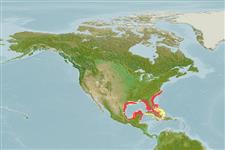Teleostei (teleosts) >
Eupercaria/misc (Various families in series Eupercaria) >
Sparidae (Porgies)
Etymology: Calamus: Greek, kalamos = reed, cane (Ref. 45335).
More on authors: Randall & Caldwell.
Environment: milieu / climate zone / depth range / distribution range
Ecology
Marine; reef-associated; depth range 7 - 90 m (Ref. 26938). Subtropical; 37°N - 18°N, 98°W - 73°W
Western Atlantic: North Carolina to southern Florida in the USA and the entire Gulf of Mexico.
Size / Weight / Age
Maturity: Lm ? range ? - ? cm
Max length : 54.4 cm TL male/unsexed; (Ref. 8889); common length : 35.0 cm TL male/unsexed; (Ref. 3815); max. published weight: 2.6 kg (Ref. 40637); max. reported age: 17 years (Ref. 8889)
Found over hard bottoms. Sometimes taken in trawls and hook and line; good food fish (Ref. 26938).
Life cycle and mating behavior
Maturity | Reproduction | Spawning | Eggs | Fecundity | Larvae
Sex change occurs at 30-50 cm TL.
Robins, C.R. and G.C. Ray, 1986. A field guide to Atlantic coast fishes of North America. Houghton Mifflin Company, Boston, U.S.A. 354 p. (Ref. 7251)
IUCN Red List Status (Ref. 130435: Version 2025-1)
Threat to humans
Harmless
Human uses
Fisheries: minor commercial; gamefish: yes
Tools
Special reports
Download XML
Internet sources
Estimates based on models
Preferred temperature (Ref.
123201): 22.8 - 27.5, mean 25 °C (based on 222 cells).
Phylogenetic diversity index (Ref.
82804): PD
50 = 0.5001 [Uniqueness, from 0.5 = low to 2.0 = high].
Bayesian length-weight: a=0.01698 (0.01093 - 0.02638), b=2.94 (2.81 - 3.07), in cm total length, based on LWR estimates for this species & Genus-body shape (Ref.
93245).
Trophic level (Ref.
69278): 3.6 ±0.31 se; based on food items.
Resilience (Ref.
120179): Medium, minimum population doubling time 1.4 - 4.4 years (K=0.17; tmax=17).
Fishing Vulnerability (Ref.
59153): Moderate to high vulnerability (50 of 100).
🛈
Nutrients (Ref.
124155): Calcium = 22.8 [9.7, 47.9] mg/100g; Iron = 0.521 [0.265, 1.091] mg/100g; Protein = 20 [19, 21] %; Omega3 = 0.174 [0.097, 0.319] g/100g; Selenium = 17.9 [8.0, 36.7] μg/100g; VitaminA = 29 [7, 121] μg/100g; Zinc = 0.613 [0.375, 0.937] mg/100g (wet weight);
